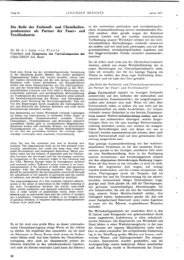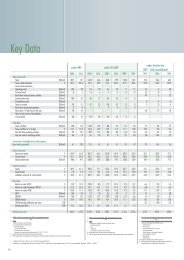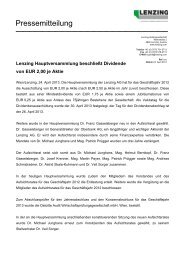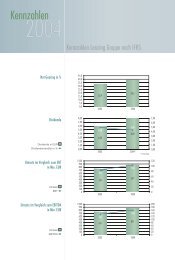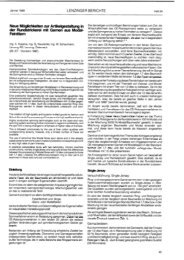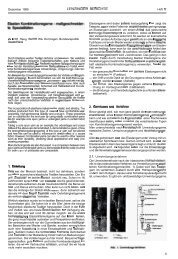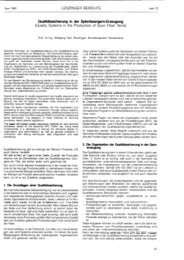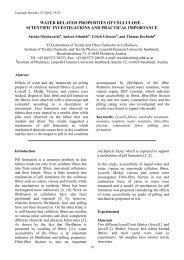Correlation of regenerated fibres morphology and surface ... - Lenzing
Correlation of regenerated fibres morphology and surface ... - Lenzing
Correlation of regenerated fibres morphology and surface ... - Lenzing
You also want an ePaper? Increase the reach of your titles
YUMPU automatically turns print PDFs into web optimized ePapers that Google loves.
<strong>Lenzing</strong>er Berichte, 82 (2003) 83-95<br />
( a − b ⋅1,<br />
33)<br />
⋅ F ⋅ 2,<br />
538<br />
ISV = (5)<br />
ma<br />
where a is volume [ml] <strong>of</strong> Na2S2O3 solution (c<br />
= 0.01 mol/l) for aliquot <strong>of</strong> blank KI solution, b<br />
is volume [ml] <strong>of</strong> Na2S2O3 solution (c = 0.01<br />
mol/l) for aliquot <strong>of</strong> sample solution, c is<br />
constant (for cellulose: 1.33), F is aliquot factor<br />
<strong>of</strong> Na2S2O3 solution, determined by KMnO4<br />
(0.02 mol/l) <strong>and</strong> ma is weight <strong>of</strong> absolutely dry<br />
fibre sample [g].<br />
Mechanical properties<br />
Stress-strain curves were measured using a<br />
Vibrodyn 400 dynamometer (<strong>Lenzing</strong> Technik<br />
Instruments) with a length between the clamps<br />
<strong>of</strong> 20 mm according to ISO 2062, linear density<br />
was determined using a Vibroskop 400<br />
(<strong>Lenzing</strong> Technik Instruments). Testing<br />
conditions were T = 20ºC, Rh = 65%, the<br />
presented data are averages from 10<br />
experiments.<br />
Sorption measurements<br />
Sorption measurements were carried out with<br />
<strong>fibres</strong> (raw <strong>and</strong> treated) placed in a cylindrical<br />
cell coming in contact with fluids <strong>of</strong> different<br />
polarity. The mass increase as a function <strong>of</strong><br />
time (capillary velocity in a fibre plug) was<br />
monitored as described in earlier publications<br />
[4]. The results presented are statistically<br />
processed average values <strong>of</strong> 10 parallel<br />
measurements. The liquids (water, ethylene<br />
glycol, formamide, ethanol, <strong>and</strong> n-heptane)<br />
used in the sorption experiments (tensiometry)<br />
were chosen because <strong>of</strong> their specific polarities<br />
[12] which are appropriate to calculate contact<br />
angles <strong>and</strong> solid’s <strong>surface</strong> energies from<br />
measured capillary velocities. A Krüss<br />
Tensiometer K12 GmbH Hamburg was used for<br />
these gravimetric measurements.<br />
Calculation <strong>of</strong> contact angle <strong>and</strong> <strong>surface</strong> free<br />
energy. The modified Washburn Equation 1<br />
[26,28,38] allows to calculate the contact angle<br />
θ from measured sorption velocities:<br />
2<br />
mass η<br />
cos θ = ⋅<br />
. (6)<br />
2 t ρ ⋅γ<br />
⋅c<br />
87<br />
1<br />
c ⋅<br />
2<br />
2 2 2<br />
= ⋅π<br />
⋅ r nk<br />
. (7)<br />
where mass 2 /t represents the sorption velocity<br />
(g 2 /s), η is liquid ’ s viscosity (mPa.s), ρ is<br />
liquid’s density (g/cm 3 ), γ is the liquid’s <strong>surface</strong><br />
tension (mN/m), θ is contact angle between<br />
solid <strong>and</strong> liquid phase ( o ), c is material constant<br />
or c factor, r is the capillary radius (m), <strong>and</strong> nk<br />
is number <strong>of</strong> capillaries.<br />
The fibre’s <strong>surface</strong> energy (γs) was determined<br />
indirectly - from the contact angle data.<br />
According to Young’s Equation (3), the <strong>surface</strong><br />
energy <strong>of</strong> a solid is given as [13]:<br />
γ s −γ SL = γ L ⋅cosθ<br />
(8)<br />
where γ represents <strong>surface</strong> tension <strong>of</strong> the solid<br />
(s) (mNm -1 ), SL the solid-liquid interface, L the<br />
liquid <strong>and</strong> θ ( o ) is the contact angle between the<br />
solid <strong>and</strong> liquid phase.<br />
Fowkes [7] proposed that the <strong>surface</strong> energy <strong>of</strong><br />
a liquid or a solid could be separated into a<br />
disperse <strong>and</strong> a polar component:<br />
γ = γ + γ<br />
s<br />
d<br />
s<br />
p<br />
s<br />
γ = γ + γ (9, 10)<br />
l<br />
where γ represents the <strong>surface</strong> energies (mJm -2 )<br />
<strong>of</strong> the solid (s), <strong>and</strong> liquid (l) with the disperse<br />
part (d) <strong>and</strong> the polar part (p). The interfacial<br />
energy <strong>of</strong> liquids <strong>and</strong> solids with both disperse<br />
<strong>and</strong> polar components are described as [13]:<br />
SL<br />
S<br />
L<br />
d<br />
l<br />
p<br />
l<br />
γ = γ + γ − 2 γ γ − 2<br />
d<br />
s<br />
d<br />
L<br />
p p<br />
γ s γ L<br />
(11)<br />
Introduction <strong>of</strong> the work <strong>of</strong> adhesion [36] <strong>and</strong><br />
conversion leads to an equation <strong>of</strong> the type:<br />
y = mx + b<br />
1 + cos θ<br />
2<br />
γ L<br />
d<br />
γ L<br />
=<br />
p<br />
γ s ∗<br />
p<br />
γ L<br />
+ d<br />
γ L<br />
d<br />
γ s<br />
(12)<br />
d<br />
p<br />
The valuesγ l , γ l <strong>and</strong> γ l are known material<br />
constants <strong>and</strong> the values <strong>of</strong> x <strong>and</strong> y can be<br />
determined. From the linear fit <strong>of</strong> the plot y<br />
versus x one gets the polar (Equation 13) <strong>and</strong><br />
disperse (Equation 14) component <strong>of</strong> <strong>surface</strong><br />
free energy [14,30]:



